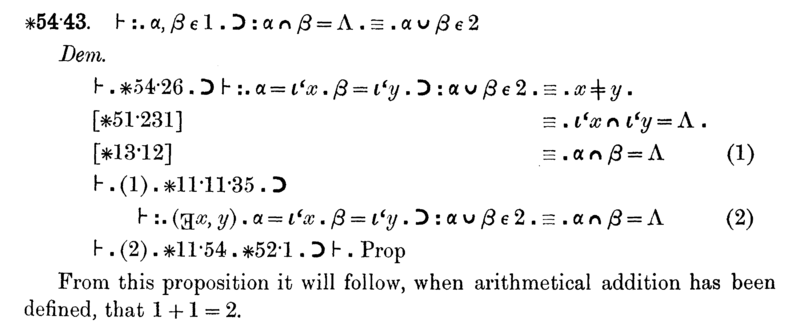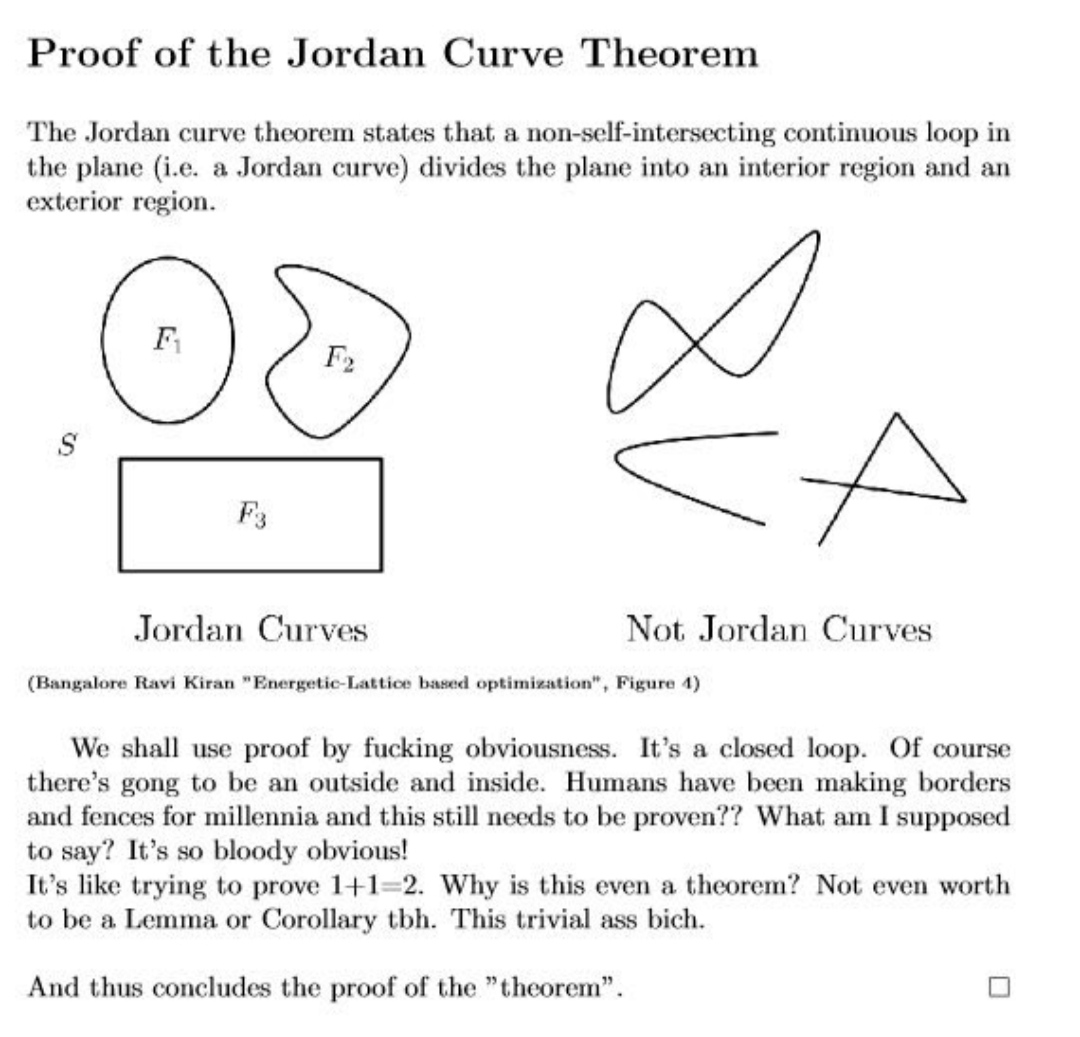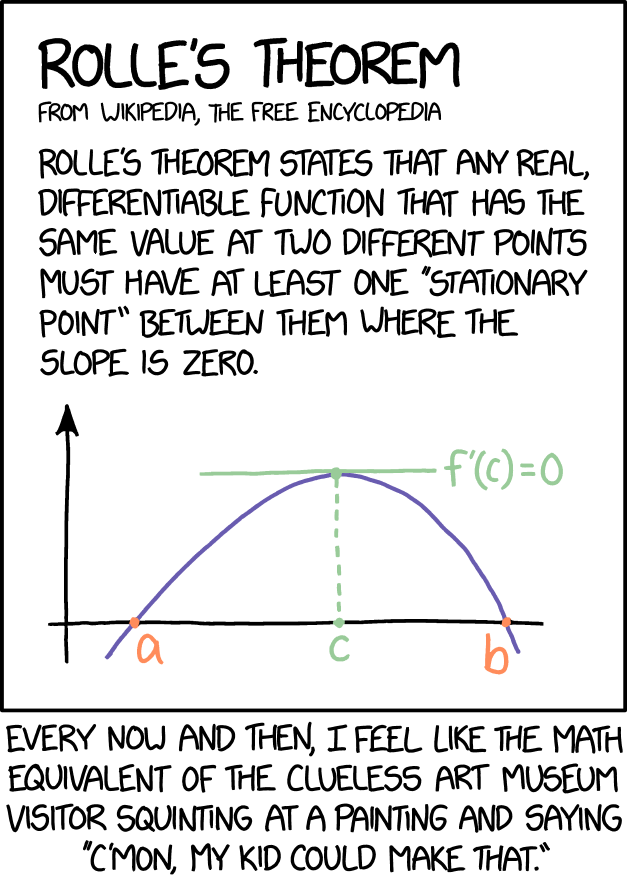This guy would not be happy to learn about the 1+1=2 proof
Math Memes
Memes related to mathematics.
Rules:
1: Memes must be related to mathematics in some way.
2: No bigotry of any kind.
One part of the 360 page proof in Principia Mathematica:

It's not a 360 page proof, it just appears that many pages into the book. That's the whole proof.
Weak-ass proof. You could fit this into a margin.
Upvoting because I trust you it's funny, not because I understand.
It's a reference to Fermat's Last Theorem.
Tl;dr is that a legendary mathematician wrote in a margin of a book that he's got a proof of a particular proposition, but that the proof is too long to fit into said margin. That was around the year 1637. A proof was finally found in 1994.
I thought it must be sonething like that, I expected it to be more specific though :)
Principia mathematica should not be used as source book for any actual mathematics because it’s an outdated and flawed attempt at formalising mathematics.
Axiomatic set theory provides a better framework for elementary problems such as proving 1+1=2.
I'm not believing it until I see your definition of arithmetical addition.
A friend of mine took Introduction to Real Analysis in university and told me their first project was “prove the real number system.”
Real analysis when fake analysis enters
I don't know about fake analysis but I imagine it gets quite complex
Isn't "1+1" the definition of 2?
That assumes that 1 and 1 are the same thing. That they’re units which can be added/aggregated. And when they are that they always equal a singular value. And that value is 2.
It’s obvious but the proof isn’t about stating the obvious. It’s about making clear what are concrete rules in the symbolism/language of math I believe.
Not a math wizard here: wouldn't either of the 1s stop being 1s if they were anything but exactly 1.0? And instead become 1.xxx or whatever?
In base 2 binary for example the digits are 0 and 1. Counting from 0 up would look like 0, 1, 10, 11, 100, 101, 110, 111, 1000, 1001, 1010, 1011, 1100, 1101, 1110, 1111, 10000, etc
In that case 1 + 1 = 10
Using the Peano axioms, which are often used as the basis for arithmetic, you first define a successor function, often denoted as •' and the number 0. The natural numbers (including 0) then are defined by repeated application of the successor function (of course, you also first need to define what equality is):
0 = 0
1 := 0'
2 := 1' = 0''
etc
Addition, denoted by •+• , is then recursively defined via
a + 0 = a
a + b' = (a+b)'
which quickly gives you that 1+1=2. But that requires you to thake these axioms for granted. Mathematicians proved it with fewer assumptions, but the proof got a tad verbose
The "=" symbol defines an equivalence relation. So "1+1=2" is one definition of "2", defining it as equivalent to the addition of 2 identical unit values.
2*1 also defines 2. As does any even quantity divided by half it's value. 2 is also the successor to 1 (and predecessor to 3), if you base your system on counting (or anti-counting).
The youtuber Vihart has a video that whimsically explores the idea that numbers and operations can be looked at in different ways.
I'll always upvote a ViHart video.
That's a bit of a misnomer, it's a derivation of the entirety of the core arithmetical operations from axioms. They use 1+1=2 as an example to demonstrate it.
Or the pigeonhole principle.
A lot of things seem obvious until someone questions your assumptions. Are these closed forms on the Euclidean plane? Are we using Cartesian coordinates? Can I use the 3rd dimension? Can I use 27 dimensions? Can I (ab)use infinities? Is the embedded space well defined, and can I poke a hole in the embedded space?
What if the parts don't self-intersect, but they're so close that when printed as physical parts the materials fuse so that for practical purposes they do intersect because this isn't just an abstract problem but one with real-world tolerances and consequences?
Yes, the paradox of Gabriel's Horn presumes that a volume of paint translates to an area of paint (and that paint when used is infinitely flat). Often mathematics and physics make strange bedfellows.
yea this is one of those theorems but history is studded with "the proof is obvious" lemmas that has taken down entire sets of theorems (and entire PhD theses)
You only needed to choose 2 points and prove that they can't be connected by a continuous line. Half of your obviousness rant
prove it then.
It's fucking obvious!
Seriously, I once had to prove that mulplying a value by a number between 0 and 1 decreased it's original value, i.e. effectively defining the unary, which should be an axiom.
Mathematicians like to have as little axioms as possible because any axiom is essentially an assumption that can be wrong.
Also proving elementary results like your example with as little tools as possible is a great exercise to learn mathematical deduction and to understand the relation between certain elementary mathematical properties.
It can’t be an axiom if it can be defined by other axioms. An axiom can not be formally proven
So you need to proof x•c < x for 0<=c<1?
Isn't that just:
xc < x | ÷x
c < x/x (for x=/=0)
c < 1 q.e.d.
What am I missing?
My math teacher would be angry because you started from the conclusion and derived the premise, rather than the other way around. Note also that you assumed that division is defined. That may not have been the case in the original problem.
isnt that how methods like proof by contrapositive work ??
Proof by contrapositive would be c<0 ∨ c≥1 ⇒ … ⇒ xc≥x. That is not just starting from the conclusion and deriving the premise.
Yeah, the four color problem becomes obvious to the brain if you try to place five territories on a plane (or a sphere) that are all adjacent to each other. (To require four colors, one of the territories has to be surrounded by the others)
But this does not make for a mathematical proof. We have quite a few instances where this is frustratingly the case.
Then again, I thought 1+1=2 is axiomatic (2 being the defined by having a count of one and then another one) So I don't understand why Bertrand Russel had to spend 86 pages proving it from baser fundamentals.
Then again, I thought 1+1=2 is axiomatic (2 being the defined by having a count of one and then another one) So I don't understand why Bertrand Russel had to spend 86 pages proving it from baser fundamentals.
Well, he was trying to derive essentially all of contemporary mathematics from an extremely minimal set of axioms and formalisms. The purpose wasn't really to just prove 1+1=2; that was just something that happened along the way. The goal was to create a consistent foundation for mathematics from which every true statement could be proven.
Of course, then Kurt Gödel came along and threw all of Russell's work in the trash.
Someone had to take him down a peg
Smarmy git, strolling around a finite space with an air of pure arrogant certainty.
Saying it was all thrown in the trash feels a bit glib to me. It was a colossal and important endeavour -- all Gödel proved was that it wouldn't help solve the problem it was designed to solve. As an exemplar of the theoretical power one can form from a limited set of axiomatic constructions and the methodologies one would use it was phenomenal. In many ways I admire the philosophical hardball played by constructivists, and I would never count Russell amongst their number, but the work did preemptively field what would otherwise have been aseries of complaints that would've been a massive pain in the arse
Yeah, the four color problem becomes obvious to the brain if you try to place five territories on a plane (or a sphere) that are all adjacent to each other.
I think one of the earliest attempts at the 4 color problem proved exactly that (that C5 graph cannot be planar). Search engines are failing me in finding the source on this though.
But any way, that result is not sufficient to proof the 4-color theorem. A graph doesn’t need to have a C5 subgraph to make it impossible to 4-color. Think of two C4 graphs. Choose one vertex from each- call them A and B. Connect A and B together. Now make a new vertex called C and connect C to every vertex except A and B. The result should be a C5-free graph that cannot be 4-colored.
Then again, I thought 1+1=2 is axiomatic (2 being the defined by having a count of one and then another one) So I don’t understand why Bertrand Russel had to spend 86 pages proving it from baser fundamentals.
It is mathematic. Of course it has to be proved.
bich

